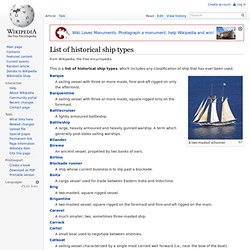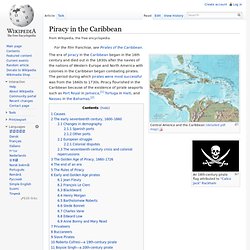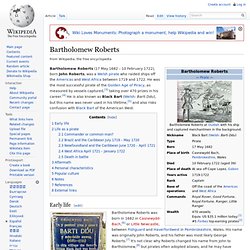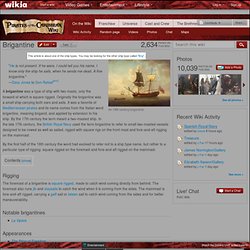

BoatSafe.com. Early Sailing Ships. Index Note: I got interested in the history of sail while transcribing the letters of a Swiss relative who died in Shanghai in 1902 while working for a European silk importer and I wondered how long it took his letters to reach home.

One question led to another and I went on a wild tour of the Internet. On these pages, I summarize what I found. Chinese ships Before discussing European vessels, we take a quick look at Chinese sailing ships [see also Wikipedia]. The typical vessel is the junk, an efficient design that is fast, easy to handle and able to sail upwind. A Brief History of Wind Powered Ships. Pink (ship) Danish three-masted ship and Spanish pink (right), by Antoine Roux.

A pink (French - pinque) is one of two different types of Sailing ship. List of historical ship types. From Wikipedia, the free encyclopedia This is a list of historical ship types, which includes any classification of ship that has ever been used.

Pirates & Privateers: The History of Maritime Piracy - The Spanish Galleons. Ships Rigging. European colonization of the Americas. European colonization of the Americas began as early as the 10th century, when Norse sailors explored and settled limited areas on the shores of present-day Greenland and Canada.[1] According to Norse folklore, violent conflicts with the indigenous population ultimately made the Norse abandon those settlements.

Extensive European colonization began in 1492, when a Spanish expedition headed by Italian Christopher Columbus sailed west to find a new trade route to the Far East but inadvertently found the Americas. European conquest, large-scale exploration, colonization and industrial development soon followed. Columbus's first two voyages (1492–93) reached the Bahamas and various Caribbean islands, including Hispaniola, Puerto Rico and Cuba. In 1497, sailing from Bristol on behalf of England, John Cabot landed on the North American coast, and a year later, Columbus's third voyage reached the South American coast. Piracy in the Caribbean. Causes[edit] Pirates were often former sailors used in naval warfare.

They were called buccaneers, from the French "boucanier" (to smoke meat) on a "boucan" (wooden frame set over a fire.)[3] By setting up smokey fires and boucans with the prepared meat of marooned cattle, these castaways could get a ship to draw near for trading, at which time the buccaneers could seize the ship. The buccaneers were later chased off the islands they lived upon by colonial powers and had to seek a new life at sea, where they continued their raiding of other ships. [citation needed] There they created lucrative but illegitimate opportunities for common seamen to attack European merchant ships (especially Spanish fleets sailing from the Caribbean to Europe) and seize their valuable cargo, a practice that began in the 16th century. —Pirate Captain Bartholomew Roberts. Full-rigged pinnace. The full-rigged pinnace was the larger of two types of vessel called a pinnace in use from the sixteenth century.

Etymology[edit] Bartholomew Roberts. Bartholomew Roberts (17 May 1682 – 10 February 1722), born John Roberts, was a Welsh pirate who raided ships off the Americas and West Africa between 1719 and 1722.

He was the most successful pirate of the Golden Age of Piracy, as measured by vessels captured,[3] taking over 470 prizes in his career.[4] He is also known as Black Bart (Welsh: Barti Ddu), but this name was never used in his lifetime,[5] and also risks confusion with Black Bart of the American West. Early life[edit] Bart Roberts' memorial stone in Casnewydd Bach Bartholomew Roberts was born in 1682 in Casnewydd-Bach,[6] or Little Newcastle, between Fishguard and Haverfordwest in Pembrokeshire, Wales. In an honest service there is thin commons, low wages, and hard labour. Life as a pirate[edit] Commander or common man? Boat and Ship Rigs. Please click here to tell your friends you like us.

The Frugal Mariner Saltwater Suzi and Cap'n Larry's "Boating on a Budget" How to's, Information, Education & Fun Stuff about Boats, Sailboats, and Cruising. Brigantine - Pirates of the Caribbean Wiki - The Unofficial Pirates of the Caribbean Encyclopedia. "He is not present.

If he were, I could tell you his name. I know only the ship he sails, when he sends me dead. A fine brigantine. " Queen Anne's Revenge. In 1718, Blackbeard ran the ship aground at Beaufort Inlet, Carteret County, North Carolina, in the present-day United States.[2] In late 1996, Intersal, a private contractor working for the state of North Carolina in marine recovery, discovered the remains of a vessel likely to be Queen Anne's Revenge.

History[edit] Blackbeard made La Concorde into his flagship, adding cannon and renaming her Queen Anne's Revenge. The name may come from the War of the Spanish Succession, known in the Americas as Queen Anne's War, in which Blackbeard had served in the Royal Navy, or possibly from sympathy for Queen Anne, the last Stuart monarch.[3] Blackbeard sailed this ship from the west coast of Africa to the Caribbean, attacking British, Dutch, and Portuguese merchant ships along the way. Discovery and archaeological excavation of shipwreck[edit] In 2011, the 1.4-tonne (3,100 lb) anchor from the ship was brought to the surface along with a range of makeshift weaponry.[9][10] In popular culture[edit] Adventure Galley. Adventure Galley, also known as Adventure, was an English sailing ship captained by William Kidd, the notorious privateer.
She was a type of hybrid ship that combined square rigged sails with oars to give her manoeuvrability in both windy and calm conditions. So I'm writing a historical fantasy that's set in the 1700s in something close to a frigate. I've been looking for videos and visuals on such ships but so far nothing has come up aside from tours that focus more on people talking than they do what's on th. Ship & Shipbuilding Terminology, complete terminology database listing.
Cannon: An artillery gun made of bronze, or from the 16th century on more increasingly made of iron and usually mounted on a wheeled gun-carriage. Europe: 1600s-1700s - Pirates & Sailors. The Vessels. In the late 17th and early 18th centuries commercial ships were generally called "merchant ships", however mariners reserved such a term for the three masted, square rigged carrier. These ships were large and intended for passengers and cargo.
The carrier was a 280 ton ship measuring 80 feet in length. While such a ship could be armed with up to 16 cannons, it is doubtful that a typical crew of about 20 could manage more than three or four such guns. Ships: The Faithful Snow. Certain ships during the great age of sail tended to lend themselves to only one specific task: the man-of-war, the bomb ketch, the coal barge. Their names even tell you what they are up to. But today’s ship, the origin of whose name is anyone’s guess, could just about do it all. The snow worked hard in the merchant service for more than four hundred years beginning in the 16th century with the last of her kind retiring in 1909. But her talents were such that she found herself working for more than one master. Nevis. Coordinates: The east coast of Nevis, partially protected by coral reefs. Long Haul Bay is seen in the foreground. The view looking inland from the Nevis airport, 2008.
Complete list of Ship Types. Pirate Ships. History of the British West Indies. Pirate Ship Crew Positions. Officers. Golden Age of Piracy. The Golden Age of Piracy is a common designation given to usually one or more outbursts of piracy in maritime history of the early modern period. Governance in 18th-century piracy. Pirates, despite being criminals, were very organized. As well as having crew members assigned certain duties, pirates found a way to reduce conflict among themselves and maximize profits.
Roles & Duties on board a Ship. Winds in the Age of Sail. Shipping_1750_1800.png (PNG Image, 1127 × 544 pixels) - Scaled (90%) Royal Naval Museum at Portsmouth Historic Dockyard. You are here > Research > Information Bank > Information Sheets#80 Pirates are sea robbers who prey on other ships and rob them of their goods and sometimes capture the ship itself for their own purposes. Piracy began over 2000 years ago in Ancient Greece, when sea robbers threatened the trading routes of Ancient Greece. Since then, this threat has continued amongst seafaring nations ever since, until the birth of regular navies.
Roman ships were attacked by pirates who seized their cargoes of grain, and olive oil. The Vikings (which means sea-raider) were renowned for attacking shipping and coastal settlements. Privateers were lawful pirates who were authorised by their government to attack and pillage ships of enemy nations. Many pirates had served in merchant or naval ships prior to turning to piracy. There were not many women pirates, as seamen believed that it was unlucky to have women onboard ships. Little Details - Sailing speed 17th 18th centuries. I'm writing a story that's an AU on an alien planet, but for all intents and purposes the ships are similar to British and Spanish vessels of 17th and 18th century Earth. I have two ships that see each other on the horizon and realize (because of location) they're friendly and turn toward each other.
How long would it take to meet? My problem is that using math and logic my equations don't match what I've read in books and seen in movies. A frigate, for example, has a mast about 125 feet tall. From the crow's nest, the horizon would be about 14 miles away. BUT. So...what am I missing? Ten Facts About Pirates. Positions and Duties on Board a Pirate Ship. Pirate Ship - The Way Of The Pirates. The Captain and Crew, , Pirates of the Caribbean, in fact and fiction.